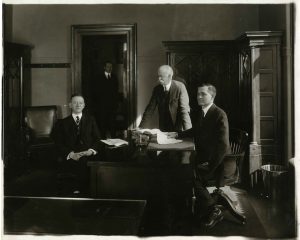How do alumni stay connected to their Alma Mater? In the case of the School of Mines (later known as the School of Mines, Engineering and Chemistry) the efforts to maintain those connections depended on two key personalities, who were dear to generations of alumni. From 1902 to 1935, Professors Ralph E. Mayer and Thomas H. Harrington served as Executive Secretary to the Alumni Association and the Columbia Engineering Alumni Association records show how the alumni kept in touch with these two beloved campus figures.
The School of Mines Alumni Association was formed as an informal social organization in 1871, and a constitution was adopted the following year. The secretary was tasked with keeping the members informed on the whereabouts of the Mines graduates. This led to the publication of several volumes of Alumni Lists, which record the positions and professional activities of the graduates.The Executive Secretaries were the ones who kept the alumni informed about each other and connected to Columbia.

The Columbia Engineering Alumni Association (CEAA) records include the expected administrative records of the group: charters and constitutional amendments, membership lists, dues and subscriptions records, and meeting minutes. But it is within the correspondence files that close-knit connections become apparent. These records contain transactional correspondence (see the orders of the crossed hammer pins from Tiffany & Co.) but they also include personal notes, postcards, wedding and birth announcements, and even baby pictures that alumni shared with the old professors, mentors and dear friends. For researchers interested in the School’s alumni, this collection, perhaps unexpectedly, is a great source for biographical and personal information. There are also letters asking for references as well as career (and life) advice.
Ralph Edward Mayer graduated from the School of Mines in 1879 with a degree in Civil Engineering. After a few years in the field, Mayer returned to Columbia as an Instructor in Drawing and later as a Professor in Engineering Draughting. Starting in 1905, he served as the Secretary of the Faculty of Applied Sciences and from 1911, the Secretary of the Committee on Instruction. But he was best remembered for his 22 years in the role of Executive Secretary to the Alumni Association (1902-1924). As the alumni noted on his passing, “[f]or many years Professor Mayer had been connected with the Alumni Association in such an intimate capacity that it would hardly be an exaggeration to say that he was the Alumni Association.” Mayer was particularly valuable to recent graduates as he helped them find positions and establish professional connections. In his memory, the alumni contributed to the Ralph Edward Mayer Fund, which was originally to be paid to his family and later to be used as a scholarship fund for Engineering students.
Thomas Henry Harrington more than ably took over from Mayer as the Executive Secretary after Mayer’s death (1924-1935). Harrington was also a Civil Engineering graduate of the School of Mines, Class of 1889. Like Mayer, he worked in the field for a few years, before joining the Engineering faculty as an Instructor in 1894 and later becoming a Professor of Engineering Drafting. He took over the role of Secretary of the Faculty of Engineering from Mayer and eventually he left the classroom to serve as Assistant Dean of the School of Engineering. But it was his role as Advisor to Pre-Engineering students that allowed him to work closely with over 1,200 students and earn him the nickname “Pop.” As the Alumni Federation Secretary C.E. Lovejoy wondered in 1935: “Is there an Engineering alumnus of the last forty years who hasn’t had favors and services galore extended to him by the one and only Tom Harrington?” After his retirement in 1935, the alumni dedicated the Thomas H. Harrington Room of the School of Engineering. This room for the social use of Engineering students was reconstructed and furnished by the Engineering Alumni Association as a tribute to Prof. Harrington and was originally located at 308 Engineering (now Mathematics).